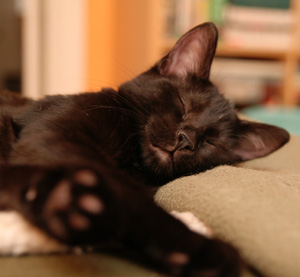Progressive Insurance is the first company to offer injury coverage for pets injured or killed in you car during a collision you caused. I didn’t realize it, but apparently many policies cover pets injured in the other car. So if someone hits your car and your cat or dog is injured or killed, don’t forget them when you file a claim with the other driver’s insurance company.
50th Anniversary Of Laika The Dog’s Orbit Of Earth
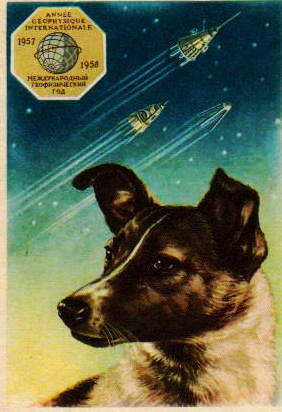 November 3rd marks 50 years since the U.S.S.R. launched Sputnik 2 carrying Laika the dog into space. She was the first living creature to orbit the earth.
November 3rd marks 50 years since the U.S.S.R. launched Sputnik 2 carrying Laika the dog into space. She was the first living creature to orbit the earth.
For years, it was believed Laika died after days in orbit, supposedly from a lethal injection. But, after the fall of the Soviet Union the world learned that although scientists had planned to euthanize her by injection, she actually died after just a few hours in orbit from overheating and stress. Either way, I think it was a hauntingly cruel fate. Sputnik 2 continued to orbit the Earth for about five months until it reentered Earth’s atmosphere and burned up on April 14, 1958.
Read more about Laika, watch this archival newsreel footage of little Laika (click on the first image of Laika to start the video), check out the original 1957 New York Times article on Sputnik 2 & Laika, visit her online memorial, and take a look at the new graphic novel, Laika, by Nick Abadzis.
I’m glad to know she at least returned to Earth.
Friday Fun: Dog-O-Ween
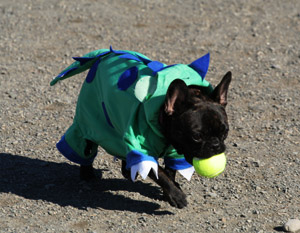
The cutest little French Bulldog Dragon, also known as Stoli
We had a good time at Dog-O-Ween, the annual fund-raiser for our local volunteer group for off-leash parks—COLA, Citizens for Off-Leash Areas. Our Saffron doesn’t wear a costume since it would make her anxious and defensive. I never thought I’d care about dogs in costumes, but the ones who don’t care or even seem amused by it are fun to watch. And I like to show support for off-leash parks.
Here are my absolute favorites. I loved these sushi dogs! Very clever, comfortable looking, and well made costumes. Yea, sushi! (Update: Here are some more pics of the sushi dogs.)
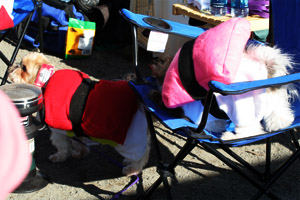
Maguro and Toro(tuna and fatty tuna)
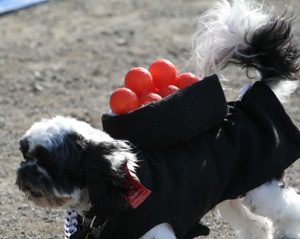
Ikura (salmon roe)
Domestic Cat’s DNA Mostly Decoded
 Cinnamon the Cat, whose DNA was decoded, is a shy Abyssinian who is also highly inbred. That inbreeding made her a great candidate for genome sequencing.
Cinnamon the Cat, whose DNA was decoded, is a shy Abyssinian who is also highly inbred. That inbreeding made her a great candidate for genome sequencing.
The new data will, of course, lead to progress in treating feline diseases, but it will also help humans. Cats and humans share about 250 genetic diseases. Cinnamon carries the gene for retinitis pigmentosa—an eye disease that can lead to blindness—which affects 1 in 3,500 Americans.
Research on hereditary diseases will benefit, but research on infectious diseases will also benefit from the DNA sequencing. The feline immunodeficiency virus (FIV) is related genetically to the human immunodeficiency virus (HIV), which causes AIDS. Scientists also decoded “genomic stretches” from retroviruses with known links to cancer.
The sequencing results will help in a number of other ways too:
“(in) parentage testing, forensic analysis, and studies of evolution, including the reconstruction of domestication processes, fancy breed development, and ecological adaptation among the great roaring cats.”
It’s interesting how much impact an inbred cat from Missouri may have on scientific progress.
Adopt A Black Cat Or Dog Part II
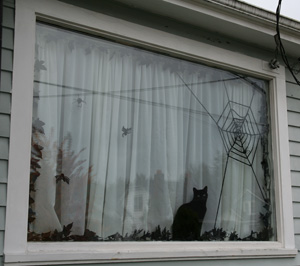
Raven completing the window decoration after having knocked a fake raven off the windowsill
I’ve written before about reasons to adopt a black dog or adopt a black cat. And why they especially need to be adopted—they are the most overlooked in shelters.
Raven was our first reason to adopt a black cat. Crow is our second.
